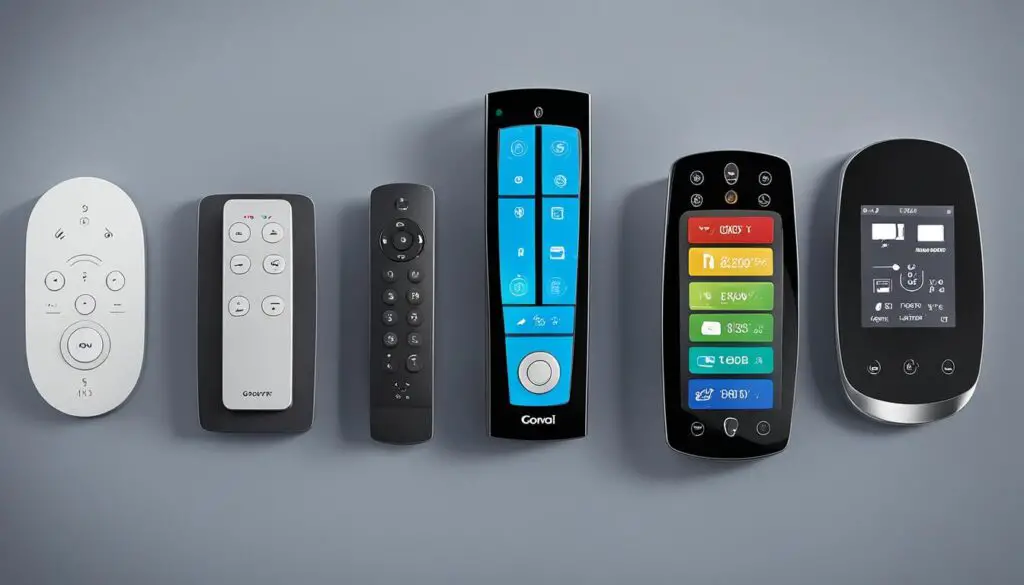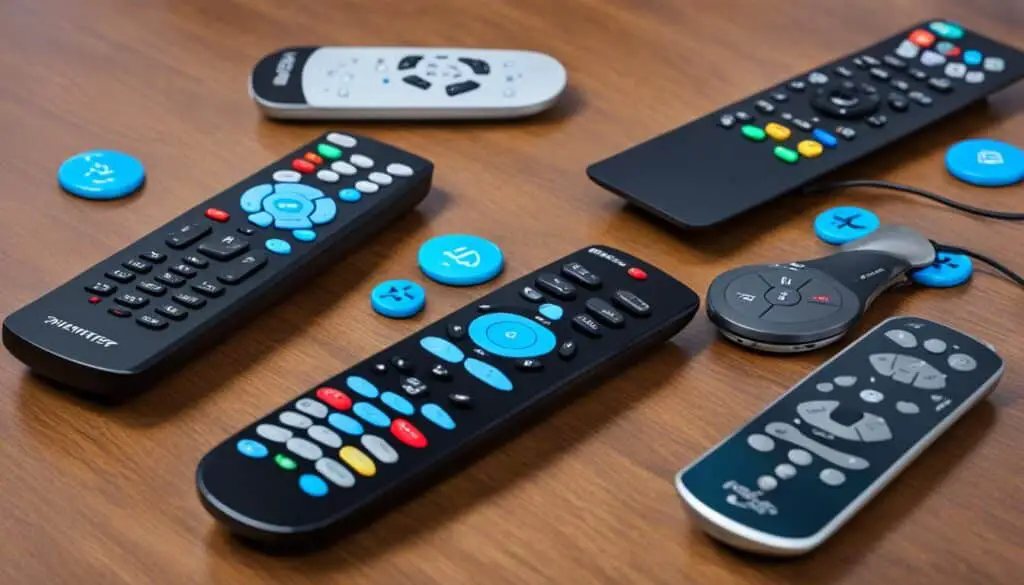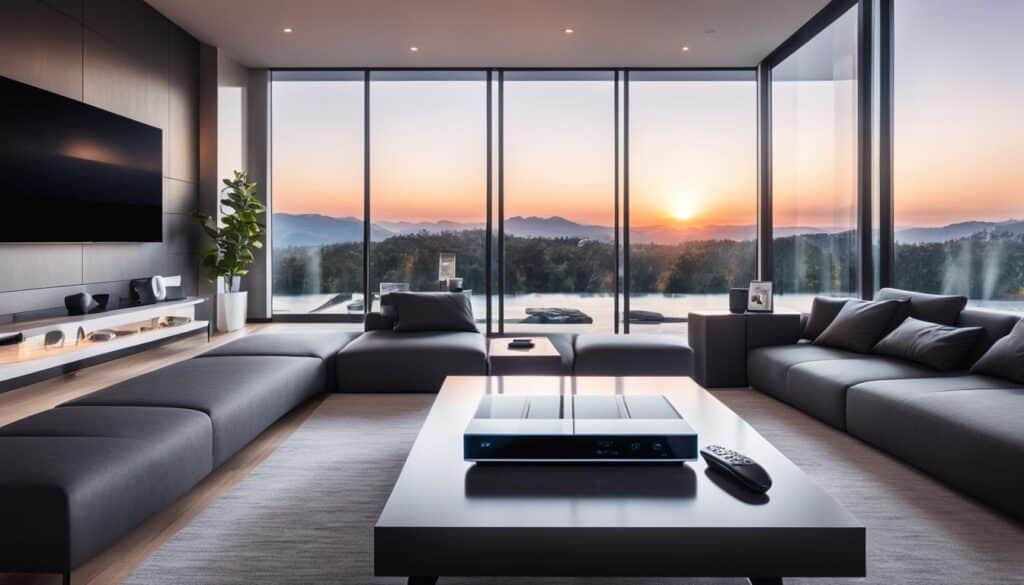Welcome to my first-timer’s guide to smart home remote controls. If you are new to the world of smart home technology or just starting to explore remote controls, this guide is for you. I will provide you with tips and insights to simplify your journey towards a connected home.
Smart home remote controls are becoming increasingly popular as more people embrace the convenience and automation that comes with smart technology. With these devices, you can control various smart devices in your home, such as lights, thermostats, security systems, and entertainment devices, from a centralized interface.
Throughout this guide, I will explain the different types of smart home remote controls available and help you choose the right one based on your needs and preferences. I will also walk you through the process of setting up and using these remote controls, as well as troubleshooting common issues that may arise.
Are you ready to take the first step towards transforming your home into a smart home? Let’s dive into the world of smart home remote controls and unlock the endless possibilities they offer!
Table of Contents
Key Takeaways:
- Understanding smart home remote controls is essential for simplifying your journey towards a connected home.
- There are different types of smart home remote controls, including handheld remotes, wall-mounted keypads, smartphone apps, and voice assistants.
- When choosing a smart home remote control, consider factors like compatibility, user interface, features, and design.
- Setting up and using smart home remote controls involves connecting them to your smart home hub or Wi-Fi network and programming specific functions.
- Troubleshooting common issues with smart home remote controls can be done by checking connectivity, updating firmware or software, and seeking manufacturer support if needed.
Enhancing Your Smart Home Experience with Automation
To fully leverage the power of your smart home remote controls, consider incorporating automation into your system. Automation allows you to set predefined actions and routines that enhance the convenience and efficiency of your smart home. Here are some ideas to get you started:
- Create Custom Scenes: Many smart home remote controls allow you to set up custom scenes that group multiple devices to work together. For example, you could create a “Movie Night” scene that dims the lights, turns on your TV, and sets the thermostat to a comfortable temperature with just one button press.
- Schedule Actions: Utilize the scheduling feature on your remote control to automate everyday tasks. For instance, you can set your smart lights to turn on at sunset or schedule your thermostat to adjust the temperature before you arrive home from work. This not only saves energy but also ensures your home is comfortable when you need it.
- Geofencing: Some smart home systems allow for geofencing, where your smart devices can automatically respond to your location. For example, your smart lights can turn off when you leave your home and turn back on when you return. This feature enhances convenience and security while saving energy.
- Integrate with Smart Sensors: Pair your remote control with smart sensors (like motion detectors or door/window sensors) to trigger automated actions. If the motion sensor detects movement, your lights could automatically turn on. If a door opens, you could receive a notification on your smartphone.
- Voice-Controlled Routines: If you’re using voice assistants alongside your smart home remote control, consider setting up voice-controlled routines. This allows you to use voice commands to initiate complex actions, such as saying “Goodnight” to turn off all the lights, lock the doors, and lower the thermostat simultaneously.
What are Smart Home Remote Controls?
Smart home remote controls are devices that revolutionize the way you interact with your smart home. They provide a centralized interface for controlling various smart devices, such as lights, thermostats, security systems, and entertainment devices, all from one convenient location.
These remote controls are designed to seamlessly connect to your smart home hub or Wi-Fi network, enabling communication and coordination with all your connected devices. With just a few taps or voice commands, you can effortlessly control and automate your smart home to suit your preferences and needs.
Smart home remote controls come packed with innovative features that enhance your smart home experience. Let’s take a closer look at some of these remarkable features:
- Voice Control: Many smart home remote controls offer voice control capabilities, allowing you to control your devices through simple voice commands. Just say the words, and your smart home will respond accordingly.
- Customizable Buttons: Personalize your remote control experience with customizable buttons. Assign your most frequently used functions to specific buttons for quick and easy access.
- Smartphone Integration: Seamlessly integrate your remote control with your smartphone for enhanced convenience. With compatible apps, you can control your smart home remotely, even when you’re away.
Overall, smart home remote controls offer a user-friendly and intuitive way to manage your smart home ecosystem. Whether you prefer tactile buttons, voice commands, or smartphone control, there’s a remote control option that suits your preferences.
| Features | Description |
|---|---|
| Voice Control | Control smart devices with simple voice commands. |
| Customizable Buttons | Personalize your remote control with your preferred functions. |
| Smartphone Integration | Control your smart home remotely using your smartphone. |
With smart home remote controls, you can effortlessly transform your living space into a connected, automated haven that caters to your needs and enhances your lifestyle.
Types of Smart Home Remote Controls
When it comes to smart home remote controls, there are several types available to suit different preferences and needs. Let’s take a closer look at some of the common types:
Handheld Remotes
Handheld remotes are similar to traditional TV remotes and provide physical buttons for controlling smart devices. They offer a familiar and tactile experience, making it easy to navigate and control your smart home devices with ease.
Wall-Mounted Keypads
Wall-mounted keypads are permanently installed on the wall and offer easy access to control multiple devices in a room. They are a convenient option for centralized control, allowing you to adjust lighting, temperature, and other smart features with just a touch.
Smartphone Apps
With the rise of smartphones, controlling your smart home is just a tap away. Smartphone apps allow you to manage and control your smart devices from anywhere, as long as you have an internet connection. They provide the flexibility and convenience of remote control on the go.
Voice Assistants
Voice assistants like Amazon Alexa and Google Assistant have become increasingly popular for controlling smart devices with voice commands. By pairing these assistants with compatible remote controls, you can enjoy hands-free control over your smart home. Simply speak your commands, and your devices will respond accordingly.
Each type of smart home remote control offers its own unique benefits and features. It’s important to consider your preferences and lifestyle when choosing the right remote control for your smart home system.
Here’s a visual representation of the different types of smart home remote controls:
| Remote Control Type | Description |
|---|---|
| Handheld Remotes | Physical buttons for controlling smart devices |
| Wall-Mounted Keypads | Permanently installed on the wall for easy access |
| Smartphone Apps | Control your smart home from anywhere using your smartphone |
| Voice Assistants | Voice control of smart devices through compatible remote controls |

Choose the type that best aligns with your preferences and lifestyle to enhance the convenience and efficiency of your smart home system.
Choosing the Right Smart Home Remote Control
When it comes to choosing a smart home remote control, there are several important factors to consider. Making the right choice will ensure seamless control and automation of your connected devices. Here are the key factors to keep in mind:
- Compatibility: Ensure that the remote control is compatible with your existing smart devices and the smart home system you have in place. Check for compatibility requirements and supported protocols.
- User Interface and Ease of Use: Consider the user interface of the remote control. Look for intuitive navigation, easy-to-understand controls, and a user-friendly layout. Avoid complex interfaces that may require technical expertise.
- Customization Options: Look for a remote control that offers customization options. This includes the ability to assign specific functions or scenes to buttons, allowing you to personalize the control experience to suit your needs.
- Voice Control Capabilities: Voice control has become increasingly popular in smart home setups. Check if the remote control supports voice commands and if it is compatible with popular voice assistants such as Amazon Alexa or Google Assistant.
- Integration with Other Smart Home Platforms: If you have other smart home devices or platforms, consider a remote control that seamlessly integrates with them. This will allow you to control all your devices from a single interface.
- Design and Aesthetics: While functionality is important, the design and aesthetics of the remote control should also be considered. Choose a remote control that complements your home’s interior design.
By taking these factors into account, you can confidently choose a smart home remote control that meets your specific needs and enhances your overall smart home experience.
Example:
I recently upgraded my smart home setup and decided to invest in a new remote control. After considering the compatibility, user interface, customization options, voice control capabilities, integration, and design, I chose the XYZ Smart Home Remote Control. It effortlessly integrates with my existing devices and smart home system, offers a user-friendly interface, and allows me to customize the control experience to my liking. Plus, its sleek design adds a touch of elegance to my living room. I couldn’t be happier with my choice!
| Factor to Consider | Example: XYZ Remote Control |
|---|---|
| Compatibility | Supports a wide range of smart devices and works seamlessly with popular smart home systems |
| User Interface and Ease of Use | Intuitive interface with simple navigation and user-friendly controls |
| Customization Options | Allows assignment of specific functions to buttons for personalized control |
| Voice Control Capabilities | Works with Amazon Alexa and Google Assistant for convenient voice control |
| Integration with Other Smart Home Platforms | Seamlessly integrates with my existing smart home devices and platforms |
| Design and Aesthetics | Sleek and stylish design that complements any home decor |
With the XYZ Remote Control, I now have complete control over my smart home devices, all from the palm of my hand. Its intuitive interface, customization options, and seamless integration make managing my smart home a breeze.

Setting Up and Using Smart Home Remote Controls
Setting up a smart home remote control is a crucial step in harnessing the full power of your smart home devices. The process will vary depending on the specific device and system you are using, but I’ll provide you with a general overview to help you get started.
To begin, make sure you have a compatible smart home hub or Wi-Fi network in place. This will serve as the central communication point for your remote control and connected devices.
Next, locate the manufacturer’s instructions that came with your remote control. These instructions will guide you through the pairing and configuration process to ensure a seamless setup.
Follow the steps provided by the manufacturer to connect your remote control to your smart home hub or Wi-Fi network. This may involve using buttons or switches on both the remote control and the hub to establish the connection. Be patient and follow the instructions carefully to avoid any potential issues.
Once your remote control is successfully connected, you can start using it to control your smart devices. Take some time to familiarize yourself with the buttons and functionalities of the remote control. Each button may have preset functions, but you can often customize them to your liking.
If you have specific scenes or routines you want to automate, you can program the remote control accordingly. This will allow you to activate multiple devices and settings with a single button press, making your smart home even more convenient.
Some smart home remote controls also offer additional control options through mobile apps or web interfaces. These companion apps can provide you with further customization capabilities and remote access to your smart home, even when you’re not at home.
Remember to keep the remote control within the range of your smart home hub or Wi-Fi network for optimal performance. If you encounter any issues during the setup or usage process, consult the manufacturer’s troubleshooting guide or reach out to their customer support for assistance.
By successfully setting up and using your smart home remote control, you’ll have the power to effortlessly control your smart devices and create a more comfortable and convenient living environment.
Troubleshooting Common Issues with Smart Home Remote Controls
While smart home remote controls offer convenience, they may encounter common issues at times. Some common issues include connectivity problems, unresponsive buttons, and compatibility issues with certain devices or systems. To troubleshoot these issues, follow these steps:
- Ensure that the remote control is connected to a stable Wi-Fi network.
- Check the batteries of the remote control to ensure they are properly inserted and functioning.
- Look for firmware or software updates for both the remote control and the connected devices. These updates often address compatibility issues and improve performance.
- If the issues persist, refer to the manufacturer’s troubleshooting guide. They usually provide detailed instructions to resolve common problems.
- If the troubleshooting guide doesn’t solve the issue, consider contacting customer support. They can provide further assistance and guide you through more advanced troubleshooting steps.
By following these troubleshooting steps, you can address common issues with smart home remote controls and ensure smooth operation of your smart devices.
Common Issues and Solutions:
Connectivity Problems: If your smart home remote control is having trouble connecting to your devices or the smart home hub, check your Wi-Fi network’s stability. Restarting your router or moving the remote control closer to the hub can often resolve connectivity issues.
Unresponsive Buttons: If the buttons on your remote control are not responding, check the batteries first. Ensure they are properly inserted and not depleted. If the issue persists, try resetting the remote control or re-pairing it with the connected devices.
Compatibility Issues: Some smart home remote controls may have compatibility issues with certain devices or systems. Before purchasing a remote control, check its compatibility list to ensure it works with your existing devices. If compatibility issues arise, consider reaching out to the manufacturer for support or considering alternative remote control options.
In case the troubleshooting steps mentioned above do not solve the issues with your smart home remote control, it is advisable to seek assistance from the manufacturer’s customer support. They have the expertise to help you navigate and resolve any challenges you may encounter.
Expanding Your Smart Home Remote Control System
As you become more comfortable with using smart home remote controls, you may want to expand your system by adding more devices. This can be done by purchasing compatible smart devices and integrating them into your existing smart home hub or network. Make sure to research compatibility and follow the manufacturer’s instructions for adding new devices to your system. Once added, you can use your smart home remote control to control and automate the new devices along with your existing ones, enhancing the functionality and convenience of your smart home.
Adding new devices to your smart home system allows you to create a more comprehensive and interconnected network that caters to your specific needs. Whether it’s incorporating smart thermostats, security cameras, or entertainment systems, expanding your smart home remote control system enables you to have centralized control over all your devices, increasing efficiency and making everyday tasks easier.
By expanding your smart home remote control system, you can unlock the full potential of your connected home. Imagine being able to turn off all the lights and lock the doors with a single command or create custom routines that automatically adjust your thermostat and play your favorite music when you arrive home. With the right devices and a smart home remote control, the possibilities for automation and personalization are endless.
However, when adding new devices to your smart home system, it’s essential to consider compatibility and ensure they integrate seamlessly with your existing setup. Research the different smart home devices available in the market and choose ones that are compatible with your smart home hub or network. This will ensure smooth communication between your remote control and the new devices, minimizing any issues or limitations.
Another consideration when expanding your smart home remote control system is the overall design and aesthetics. Choose devices that not only offer the desired functionality but also complement the style and decor of your home. Smart home technology has come a long way, and you can find devices that blend seamlessly into your existing setup, enhancing the overall ambiance of your living space.
To assist you in your journey of expanding your smart home remote control system, refer to the table below. It provides an overview of compatible devices and their key features:
| Device | Compatibility | Key Features |
|---|---|---|
| Smart Thermostat | Compatible with most smart home systems | Temperature scheduling, energy-saving features, voice control |
| Smart Security Camera | Works with popular smart home hubs and security systems | Live video streaming, motion detection, two-way audio |
| Smart Speaker | Integrates with major voice assistant platforms | High-quality audio, voice control, smart home hub functionality |
| Smart Lighting | Compatible with a variety of smart home systems | Dimming capabilities, color-changing options, scheduling |
With the right devices and the power of smart home remote control, you can transform your house into a truly connected and automated haven. Take control of your everyday life with the convenience and efficiency of a smart home remote control system, and enjoy the benefits of a seamlessly integrated smart home.
Conclusion
In conclusion, smart home remote controls offer a convenient and centralized way to control and automate your smart devices. With a wide range of options available, understanding the types of remote controls and choosing the right one for your needs is essential. By following the setup and troubleshooting steps, you can easily navigate the world of smart home technology and enjoy the benefits of a connected home.
Whether you are a first-timer exploring the possibilities of smart home technology or you are looking to expand your existing system, remote controls can simplify your experience and put the power of automation at your fingertips. From controlling lights and thermostats to setting up personalized scenes, these smart devices offer convenience and enhance the functionality of your home.
Take the time to research and choose a remote control that is compatible with your smart devices and integrates seamlessly with your existing smart home system. By doing so, you can create a customized and personalized smart home experience that suits your lifestyle and preferences.
FAQ
What are smart home remote controls?
Smart home remote controls are devices that allow you to control various smart devices in your home, such as lights, thermostats, security systems, and entertainment devices, from a centralized interface. They usually connect to a smart home hub or a Wi-Fi network to enable communication with the connected devices. Smart home remote controls often come with features like voice control, customizable buttons, and smartphone integration for convenient control and automation of your smart home.
What are the types of smart home remote controls?
Some common types of smart home remote controls include handheld remotes, wall-mounted keypads, smartphone apps, and voice assistants. Handheld remotes are similar to traditional TV remotes and provide physical buttons for controlling smart devices. Wall-mounted keypads are permanently installed on the wall and offer easy access to control multiple devices in a room. Smartphone apps allow you to control your smart home from anywhere using your smartphone. Voice assistants like Amazon Alexa and Google Assistant enable voice control of your smart devices through compatible remote controls.
What factors should I consider when choosing a smart home remote control?
When choosing a smart home remote control, consider the compatibility of the remote control with your existing smart devices and the smart home system you have in place. Additionally, think about the user interface and ease of use, customization options, voice control capabilities, integration with other smart home platforms, and the design and aesthetics of the remote control.
How do I set up and use a smart home remote control?
Setting up a smart home remote control will vary depending on the specific device and system you are using. Typically, you need to connect the remote control to your smart home hub or Wi-Fi network and follow the manufacturer’s instructions for pairing and configuration. Once set up, you can start using the remote control to control your smart devices. Some remote controls may require programming and assigning specific functions or scenes to the buttons. You may also have the option to customize and control your devices further through mobile apps or web interfaces.
What are some common issues with smart home remote controls?
Some common issues with smart home remote controls include connectivity problems, unresponsive buttons, and compatibility issues with certain devices or systems. To troubleshoot these issues, ensure that the remote control is connected to a stable Wi-Fi network and that the batteries are properly inserted and functioning. Check for firmware or software updates for both the remote control and the connected devices. If the issues persist, refer to the manufacturer’s troubleshooting guide or contact customer support for further assistance.
How can I expand my smart home remote control system?
You can expand your smart home remote control system by purchasing compatible smart devices and integrating them into your existing smart home hub or network. Make sure to research compatibility and follow the manufacturer’s instructions for adding new devices to your system. Once added, you can use your smart home remote control to control and automate the new devices along with your existing ones, enhancing the functionality and convenience of your smart home.


